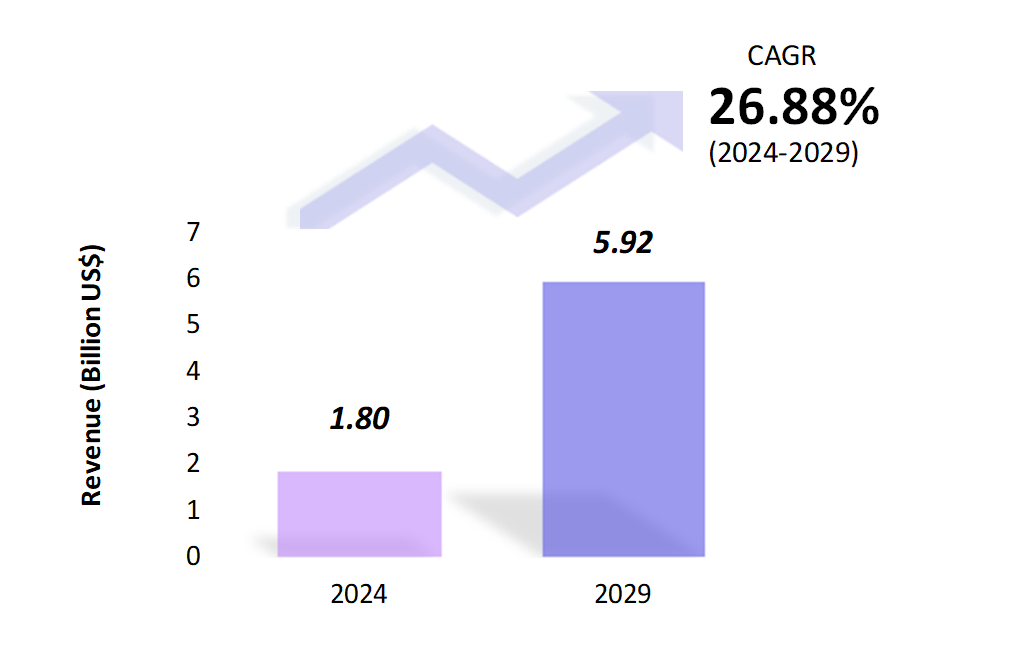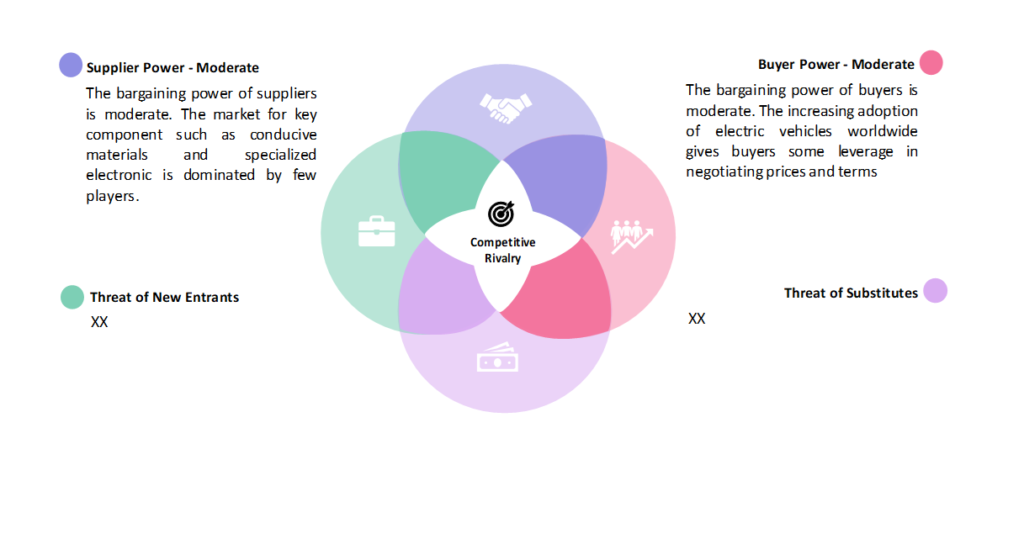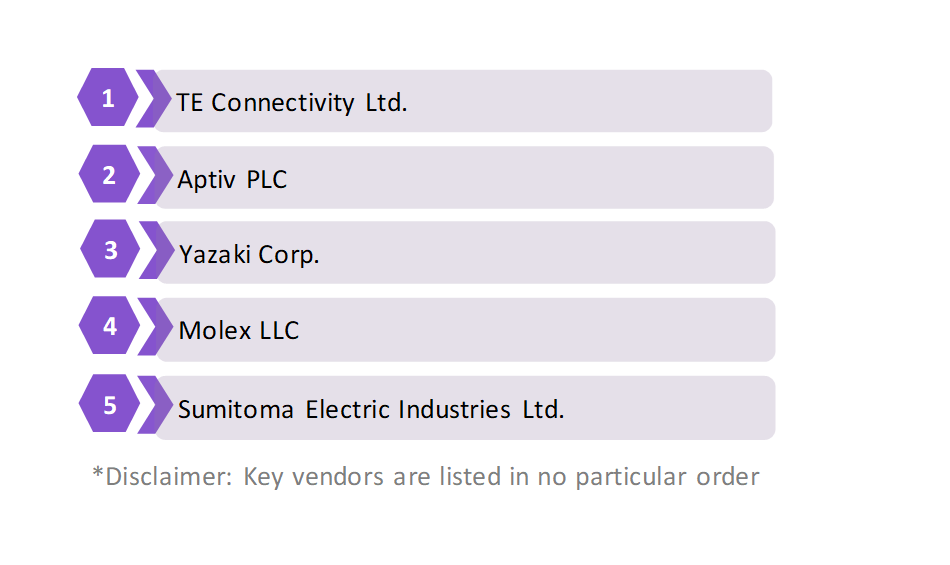EV Connector Market: Size, Share, Trends & Forecast (2024-2029)
The report covers a comprehensive analysis segmented by Charging Type (Type 1, Type 2, Type 3), By Level (Level 1, Level 2, Level 3, Level 4), By Voltage Type (AC Charging, DC Charging), By Speed Type (Slow, Fast, Rapid), By Geography (North America, South America, Asia Pacific, Europe, the Middle East, Africa).
EV Connector Market Snapshot

EV Connector Market Overview
The market for EV connectors is expected to grow from its estimated to be at $1.8 Bn in 2024 and is anticipated to reach $5.92 Bn in 2029. Between 2024 and 2029, the global EV connector market is expected to grow at a compound annual growth rate (CAGR) of 26.88%. The popularity of electric vehicles is expected to grow significantly in the next decade due to technological progress, charging infrastructure, and grid integration. Further technical improvements such as intelligent charging infrastructure, reliable communications systems, and coordinated charging systems are essential for EVs to achieve maximum profits with distributed generators. A future grid technology based on the Energy Internet, which can enable the electrical grid to become fully automated with advanced energy management systems. Optimal charging scheduling techniques can take advantage of EVs flexibility as a load while minimizing solar and wind system impacts on the grid. The transportation and electric power sectors have only recently become linked.
Electric utilities have seen substantial disruptions because of large scale electrification of transport. Apart from presenting significant challenges for the power grid, electric vehicles have also offered significant benefits. Traditionally, the most critical part of electric vehicle battery is the electric vehicle grid integration (EVGI). It might be possible for EVs to play a significant role in returning electricity to the grid and providing services such as harmonic reduction, reactive power supply, etc., in an intelligent energy management environment.
Alternatively, business operations cover areas such as Power Generation (GENCO), Transmission (TSO), Distribution (DSO), Retailers (SA), also referred to as load-serving organizations and customers who charge vehicles at charging stations. EV aggregators usually group EVs based on owner preferences to maximize commercial opportunities within the power industry. EVs alone contribute marginally and inefficiently to the industry, but the contribution can be enhanced if EVs and EV aggregators work together.
EV Connector Market Coverage
| Historical & Forecast Period | 2018-2029 |
| Base Year | 2023 |
| Forecast Period | 2024-2029 |
| Units | Billion US$ |
| Segments | Charging Type, Level, Voltage Type, Speed Type |
| Geographies | North America, South America, Asia Pacific, Europe, The Middle East, Africa |
| Key Vendors | TE Connectivity Ltd., Aptiv PLC, Yazaki Corp., Molex LLC, Sumitomo Electric Industries Ltd. |
Key Geographies of EV Connector Market, 2023

Porter’s 5 Forces Analysis of EV Connector Market

EV Connector Market Trends
Due to technological advancements, existing grids are being transformed into smart grids. As a result of smart grids, EV customers will use the bidirectional power flow to reduce their capital investment and create a second income source from the V2G technology. In addition to helping EV users, this V2G technology also helps service providers maintain the scalability of the network, making it more reliable, reducing blackouts, system degradation and losses relating to overload.
Range anxiety must be addressed by increasing battery capacity for Rich Communication Services (RCS) penetration in the existing grid for better EV adoption. It is possible to switch to lithium-sulfur batteries since they have higher capacity and longer life. A sulfur-based battery can be easily manufactured due to the availability of sulfur. With its integration into smart grid implementation and its optimal seat position, RCS will significantly reduce range anxiety for EV drivers and make EV charging more convenient for users. The current grid may not be able to meet the load with an increase in EV penetration if there is an increased cost focus.
Upgrades and stabilization of the grid are essential. It will be necessary to discuss the integration of distributed generation (DG) systems as these can reduce the environmental effects of coal-and gasoline-fired power plants and be easily installed. Flexibility and adaptability are key qualities in navigating the complexities of future scenarios.
EV Connector Market Driving Factors
Zero tailpipe emissions will be produced when electric vehicles are combined with low carbon energy. Moreover, internal combustion engines emit significantly more greenhouse gas than alternative energy resources. These goals determine policies supporting the development and implementation of electric power trains for transportation in many countries. 17 countries have committed to eliminating internal combustion engine vehicles or achieving zero-carbon emission standards for automotive vehicles by 2050.
France became the first nation to legislate a deadline for this in December 2019 by setting a target date of 2040. Policy and incentive decisions regarding electric vehicles are heavily influenced by the current state of the electric vehicle industry. Public demonstration of the technology on government vehicles and public transportation is the best way to increase adoption, enabling businesses and organizations to lead by example. Most government policies and incentives revolve around tax exemptions and credits, unit cost reductions, and access to hotspots for parking. Regulations and financial incentives are likely to accelerate the adoption of electric vehicles, setting definite goals and objectives for the industry. In response to many of these regulations, many manufacturers are required to make hybrid cars and cars with higher fuel efficiency.
Increasing government incentives worldwide for the purchase of electric vehicles is a principal factor driving the EV connector market. For example, Chinese government is encouraging the use of electric vehicles instead of traditional gasoline-powered vehicles through large investments and subsidies. Due to the abundance of electric vehicles, there is a need for rapid development of EV connectors as well. Thus, the efforts of global companies to prioritize electric vehicles will enable the EV connector market to move forward and make massive strides.
EV connector Market Challenges
Electric vehicles have been considered a trend and the future of transportation because of their ability to overcome all current challenges regarding conventional sources, such as depletion of fossil fuels, increase in greenhouse gas emission, and global warming. Despite this, it has been seen that EV adoption presents some disadvantages as well, which includes penetration into existing networks that increase the load, resulting in more blackouts and losses through overloading, the battery service capacity, range anxiety, and the overall excessive cost of EVs when compared to internal combustion engines. The cost of EVs remains higher than those of internal combustion engines due to the charging infrastructure and the battery installation within the car. Lithium-ion batteries, for example, have a minimal life cycle and poor energy density.
EVs must have a Rich Communication Services (RCS), which is not widely available , to function as next-generation transportation. Alternative fueling stations are available through RCS. Reduced charging time and range anxiety are the two main benefits of RCS. In the EV connector market, Level 3 chargers, also known as direct current (DC) fast chargers, provide significantly higher outputs, compared to Level 1 and Level 2 chargers. Level 3 charging is essential for long distance travel and high-demand scenarios, such as highway rest stops. However, it requires specialized infrastructure and is more costly to implement compared to Level 1 and Level 2 charging.
EV connector Market – Key Industry News
- In March 2024, EV Connect, Inc., a leading EV charging business platform has announced that LG Business Solutions Ltd. has joined its Electric Vehicle Charge Station (EVCS) Certification Program. The new Level 2 charging stations from LG for the North American market are now fully certified for operation on the EV connect platform and within its charging ecosystem.
- In January 2024, WiTricity Corp., a major player in wireless EV charging technology, announced KG Mobility Co. Ltd. all-new, all-electric Torres EVX pickup will offer WiTricity-enabled wireless charging. The option will be available beginning with the 2025 model year Torres EVX pickup.
- In October 2022, SAE International- an association of engineers and technical transport experts- finalized the first standard for stationery wireless charging for light-duty vehicles, a category that includes passenger cars. The standard covers everything from safe charging speed (up to 11 kilowatts) to interoperability and performance.
EV connector Market Competitive Landscape
The participants in the global EV connector industry is always developing their strategies to preserve a competitive advantage. Companies primarily use acquisitions, R&D, partnerships, and technological launches. Several important entities in the EV connector market include TE Connectivity Ltd., Aptiv PLC, Yazaki Corp., Molex LLC, Sumitomo Electric Industries Ltd., and others. The business models for providing EV charging will vary depending on companies’ core competencies, strategic objectives and market positioning. Whether through partnerships with EV charging operators or through vertical integration, companies can leverage EV charging to enhance customer satisfaction, strengthen brand positioning, and drive long term value creation.
EV connector Market Company Share Analysis, 2023 (%)

EV connector Market – Key Companies

Reason to Buy from us

Table of Contents
| 1. Introduction |
| 1.1. Research Methodology |
| 1.2. Scope of the Study |
| 2. Market Overview / Executive Summary |
| 2.1. Global EV connector Market (2018 – 2022) |
| 2.2. Global EV connector Market (2023 – 2029) |
| 3. Market Segmentation |
| 3.1. Global EV connector Market by Charging Type |
| 3.1.1. Type 1 |
| 3.1.2. Type 2 |
| 3.1.3. Type 3 |
| 3.2. Global EV connector Market by Level |
| 3.2.1. Level 1 |
| 3.2.2. Level 2 |
| 3.2.3. Level 3 |
| 3.2.4. Level 4 |
| 3.3. Global EV connector Market by Voltage Type |
| 3.3.1. AC Charging |
| 3.3.2. DC Charging |
| 3.4. Global EV connector Market by Speed Type |
| 3.4.1. Slow |
| 3.4.2. Fast |
| 3.4.3. Rapid |
| 4. Regional Segmentation |
| 4.1. North America |
| 4.1.1. The U.S |
| 4.1.2. Canada |
| 4.1.3. Mexico |
| 4.2. South America |
| 4.2.1. Brazil |
| 4.2.2. Argentina |
| 4.2.3. Colombia |
| 4.2.4. Chile |
| 4.2.5. Rest of South America |
| 4.3. Asia Pacific |
| 4.3.5. Rest of Asia Pacific |
| 4.4. Europe |
| 4.4.1. UK |
| 4.4.2. Germany |
| 4.4.3. Italy |
| 4.4.4. France |
| 4.4.5. Spain |
| 4.4.6. Rest of Europe |
| 4.5. The Middle East |
| 4.5.1. Turkey |
| 4.5.2. UAE |
| 4.5.3. Saudi Arabia |
| 4.5.4. Rest of the Middle East |
| 4.6. Africa |
| 4.6.1. Egypt |
| 4.6.2. South Africa |
| 4.6.3. Rest of Africa |
| 5. Value Chain Analysis of the Global EV connector Market |
| 6. Porter Five Forces Analysis |
| 6.1. Threats of New Entrants |
| 6.2. Threats of Substitutes |
| 6.3. Bargaining Power of Buyers |
| 6.4. Bargaining Power of Suppliers |
| 6.5. Competition in the Industry |
| 7. Trends, Drivers and Challenges Analysis |
| 7.1. Market Trends |
| 7.1.1. Market Trend 1 |
| 7.1.2. Market Trend 2 |
| 7.1.3. Market Trend 3 |
| 7.1.4. Market Trend 4 |
| 7.1.5. Market Trend 5 |
| 7.2. Market Drivers |
| 7.2.1. Market Driver 1 |
| 7.2.2. Market Driver 2 |
| 7.2.3. Market Driver 3 |
| 7.2.4. Market Driver 4 |
| 7.2.5. Market Driver 5 |
| 7.3. Market Challenges |
| 7.3.1. Market Challenge 1 |
| 7.3.2. Market Challenge 2 |
| 7.3.3. Market Challenge 3 |
| 7.3.4. Market Challenge 4 |
| 7.3.5. Market Challenge 5 |
| 8. Regulatory Landscape |
| 9. Competitive Landscape |
| 9.1. TE Connectivity Ltd. |
| 9.2. Aptiv PLC |
| 9.3. Yazaki Corp. |
| 9.4. Molex LLC |
| 9.5. Sumitoma Electric Industries Ltd. |
| 9.6. Company 6 |
| 9.7. Company 7 |
| 9.8. Company 8 |
| 9.9. Company 9 |
| 9.10. Company 10 |
EV connector Market – Frequently Asked Questions (FAQs)
What is the current size of the global EV connector market?
The market size for the global EV connector market in 2024 is $1.80 Bn.
Who are the major vendors in the global EV connector market?
The major vendors in the global EV connector market are TE Connectivity Ltd., Aptiv PLC, Yazaki Corp., Molex LLC, Sumitomo Electric Industries Ltd.
Which segments are covered under the global EV connector market segments analysis?
This report offers in-depth insights into each charging type, level, voltage type, speed type.
